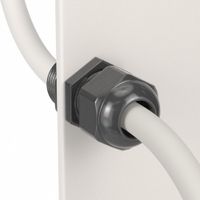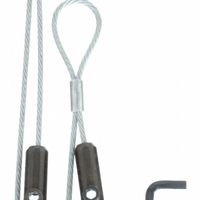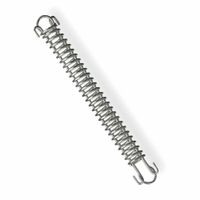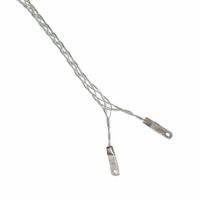Call +(254) 703 030 000 / 751 483 999 / 721 704 777
- Home
- Electrical
- Wire Cable Management
- Cable Grips Mesh Grips Safety Springs
.....Read More
Frequently Asked Questions
What are cable grips and how do they work?
Cable grips, also known as cable socks or cable stockings, are devices used to secure, support, and manage cables in various applications. They are typically made from woven steel wire or synthetic materials, forming a flexible, mesh-like structure that can expand and contract. This design allows the grip to fit snugly around cables of different sizes.
Cable grips work by utilizing the principle of friction and tension. When a cable is inserted into the grip, the mesh structure tightens around the cable as tension is applied. This tightening action increases the friction between the grip and the cable, effectively holding the cable in place. The more tension applied, the tighter the grip becomes, ensuring a secure hold.
These grips are used in a variety of applications, including:
1. **Cable Pulling**: During installation, cable grips are used to pull cables through conduits or ducts. The grip is attached to the end of the cable, and as it is pulled, the grip tightens, allowing for efficient and secure cable installation.
2. **Cable Support**: In vertical installations, cable grips can support the weight of the cable, preventing sagging and reducing strain on connectors and terminations.
3. **Strain Relief**: Cable grips provide strain relief by absorbing tension and preventing it from being transferred to sensitive connections, reducing the risk of damage.
4. **Temporary Holding**: They can temporarily hold cables in place during maintenance or repair work.
Cable grips are essential tools in industries such as telecommunications, construction, and electrical engineering, where they ensure the safe and efficient handling of cables.
How do you install mesh grips for cable support?
1. **Select the Right Mesh Grip**: Choose a mesh grip suitable for the cable size and type. Ensure it matches the cable's diameter and load requirements.
2. **Prepare the Cable**: Clean the cable surface to remove any dirt or debris. This ensures a secure grip and prevents slippage.
3. **Position the Mesh Grip**: Slide the open end of the mesh grip over the cable end. Ensure the grip is positioned where support is needed, typically near the cable's midpoint or end.
4. **Secure the Grip**: Pull the mesh grip tightly over the cable. The grip should snugly encase the cable without any slack. For split mesh grips, wrap the grip around the cable and interlock the ends.
5. **Attach to Support Structure**: Connect the eye or loop of the mesh grip to a secure anchor point. This could be a beam, hook, or other structural support. Use appropriate hardware like shackles or carabiners to ensure a secure attachment.
6. **Tension the Cable**: Gradually apply tension to the cable to ensure the mesh grip tightens and holds the cable securely. Avoid excessive force that could damage the cable or grip.
7. **Inspect the Installation**: Check the grip for proper alignment and tension. Ensure there are no twists or kinks in the cable or grip. Verify that the attachment point is secure and capable of supporting the load.
8. **Test the Setup**: If possible, conduct a load test to confirm the grip's effectiveness. Monitor for any slippage or movement.
9. **Regular Maintenance**: Periodically inspect the mesh grip and cable for wear and tear. Replace the grip if any damage or degradation is observed.
What are the different types of cable grips available?
There are several types of cable grips available, each designed for specific applications and cable types:
1. **Pulling Grips**: Used for pulling cables through conduits or ducts. They are designed to grip the cable securely without causing damage during installation.
2. **Support Grips**: These grips are used to support the weight of vertical or sloping cables, preventing stress and strain on the cable. They are often used in overhead or tower applications.
3. **Strain Relief Grips**: Designed to prevent cable pull-out and reduce strain on the cable connection points. They are commonly used in electrical enclosures and machinery.
4. **Conduit Riser Grips**: Used to support cables in vertical conduit risers, ensuring that the cable does not slip or become damaged.
5. **Rotating Eye Pulling Grips**: These grips have a rotating eye that allows the cable to spin freely, reducing the risk of twisting and kinking during installation.
6. **Lace-Up Grips**: These are flexible and can be wrapped around the cable, then laced up to secure the grip. They are useful for irregularly shaped cables or bundles.
7. **Closed Mesh Grips**: Provide a secure hold on the cable with a closed mesh design, often used for permanent installations.
8. **Split Mesh Grips**: Feature a split design that allows them to be installed on existing cables without disconnecting them.
9. **Double Weave Grips**: Offer extra strength and durability with a double weave pattern, suitable for heavy-duty applications.
10. **Single Weave Grips**: Lighter and more flexible, suitable for less demanding applications.
11. **Flexible Eye Grips**: Have a flexible eye for easy attachment to pulling lines or other equipment.
12. **Offset Eye Grips**: Designed with an offset eye for applications where space is limited or alignment is crucial.
Each type of cable grip is tailored to specific needs, ensuring safe and efficient cable management and installation.
How do you choose the right cable grip for a specific application?
To choose the right cable grip for a specific application, consider the following factors:
1. **Cable Type and Size**: Identify the type and diameter of the cable. Cable grips are designed to accommodate specific cable sizes and types, such as armored, unarmored, or fiber optic cables.
2. **Application Environment**: Assess the environmental conditions where the cable grip will be used. Consider factors like temperature, moisture, chemical exposure, and UV radiation. For harsh environments, select grips made from corrosion-resistant materials like stainless steel or nylon.
3. **Load Requirements**: Determine the mechanical load the grip needs to support. This includes the weight of the cable and any additional forces, such as tension or compression. Choose a grip with a load rating that meets or exceeds these requirements.
4. **Grip Type**: Decide on the type of grip needed based on the application. Options include pulling grips for cable installation, support grips for vertical or horizontal cable support, and strain relief grips to prevent cable damage at connection points.
5. **Installation Method**: Consider the ease of installation and removal. Some grips are designed for temporary use and can be easily removed, while others are permanent. Ensure the grip can be installed with the available tools and within the space constraints of the application.
6. **Compliance and Standards**: Ensure the cable grip complies with relevant industry standards and regulations, such as those from the National Electrical Manufacturers Association (NEMA) or the International Electrotechnical Commission (IEC).
7. **Manufacturer Recommendations**: Consult the manufacturer's specifications and recommendations for compatibility and performance to ensure the grip is suitable for the intended application.
By evaluating these factors, you can select a cable grip that ensures safety, reliability, and efficiency in your specific application.
What are the safety considerations when using cable grips and mesh grips?
When using cable grips and mesh grips, several safety considerations must be taken into account:
1. **Load Capacity**: Ensure the grip is rated for the specific load it will carry. Overloading can lead to grip failure.
2. **Inspection**: Regularly inspect grips for wear, corrosion, or damage. Replace any grips showing signs of deterioration.
3. **Installation**: Follow manufacturer guidelines for installation. Incorrect installation can compromise grip effectiveness and safety.
4. **Compatibility**: Use grips that are compatible with the cable type and size. Mismatched grips can slip or fail.
5. **Environment**: Consider environmental factors such as temperature, moisture, and chemical exposure, which can affect grip performance.
6. **Tension**: Avoid excessive tension during installation and use. Over-tensioning can damage both the grip and the cable.
7. **Secure Attachment**: Ensure grips are securely attached to prevent slippage. Use appropriate connectors and fasteners.
8. **Training**: Personnel should be trained in the proper use and handling of cable grips to prevent accidents.
9. **Personal Protective Equipment (PPE)**: Use appropriate PPE, such as gloves and safety glasses, to protect against injury during installation and removal.
10. **Testing**: Conduct regular testing to ensure grips maintain their holding capacity and integrity.
11. **Storage**: Store grips in a dry, cool place to prevent damage from environmental factors.
12. **Documentation**: Keep records of inspections, maintenance, and any incidents to ensure ongoing safety and compliance.
13. **Emergency Procedures**: Have emergency procedures in place in case of grip failure or related accidents.
By adhering to these safety considerations, the risk of accidents and equipment failure can be minimized, ensuring a safer working environment.
How do you maintain and inspect cable grips for wear and tear?
To maintain and inspect cable grips for wear and tear, follow these steps:
1. **Regular Inspection**: Schedule routine inspections based on usage frequency and environmental conditions. Inspect cable grips visually for any signs of damage, such as fraying, corrosion, or deformation.
2. **Cleaning**: Clean the cable grips regularly to remove dirt, grease, and other contaminants. Use a mild detergent and water, ensuring the grips are thoroughly dried afterward to prevent rust.
3. **Check for Corrosion**: Examine metal components for rust or corrosion. If corrosion is present, clean it with a wire brush and apply a rust inhibitor.
4. **Examine for Fraying**: Look for frayed wires or broken strands in the cable grip. Fraying can compromise the grip's integrity and should be addressed immediately.
5. **Assess Deformation**: Check for any bending or warping of the grip. Deformation can indicate overloading or improper use.
6. **Lubrication**: Apply appropriate lubricants to moving parts to ensure smooth operation and reduce wear.
7. **Test Functionality**: Conduct functional tests to ensure the grip holds the cable securely without slipping. This can involve applying a load to see if the grip maintains its hold.
8. **Replacement**: Replace any cable grips that show significant wear, damage, or fail functional tests. Always use grips that meet the required specifications for the application.
9. **Documentation**: Keep detailed records of inspections, maintenance activities, and replacements. This helps track the condition of cable grips over time and ensures compliance with safety standards.
10. **Training**: Ensure personnel involved in the inspection and maintenance of cable grips are adequately trained and aware of the latest safety standards and procedures.
What are the benefits of using cable safety springs in industrial settings?
Cable safety springs offer several benefits in industrial settings:
1. **Shock Absorption**: They absorb and dissipate energy from sudden loads or impacts, reducing the risk of cable breakage and equipment damage.
2. **Vibration Dampening**: By minimizing vibrations, they help maintain the integrity of cables and connected machinery, leading to longer equipment life and reduced maintenance costs.
3. **Load Distribution**: They evenly distribute loads across the cable, preventing localized stress points that could lead to premature wear or failure.
4. **Enhanced Safety**: By preventing cable snap-back in case of failure, they protect workers from potential injuries, contributing to a safer work environment.
5. **Increased Cable Lifespan**: By reducing mechanical stress and wear, they extend the service life of cables, leading to cost savings on replacements and repairs.
6. **Operational Efficiency**: With reduced downtime due to cable failures, operations can run more smoothly and efficiently, improving overall productivity.
7. **Versatility**: They can be used in various applications, including cranes, hoists, and other lifting equipment, making them a versatile solution for different industrial needs.
8. **Compliance with Safety Standards**: Using cable safety springs can help meet industry safety regulations and standards, ensuring legal compliance and reducing liability risks.
9. **Cost-Effectiveness**: While they require an initial investment, the long-term savings from reduced maintenance, fewer replacements, and enhanced safety make them a cost-effective solution.
10. **Easy Installation**: They are generally easy to install and integrate into existing systems, minimizing disruption during implementation.
Overall, cable safety springs enhance the reliability, safety, and efficiency of industrial operations, making them a valuable component in various applications.




